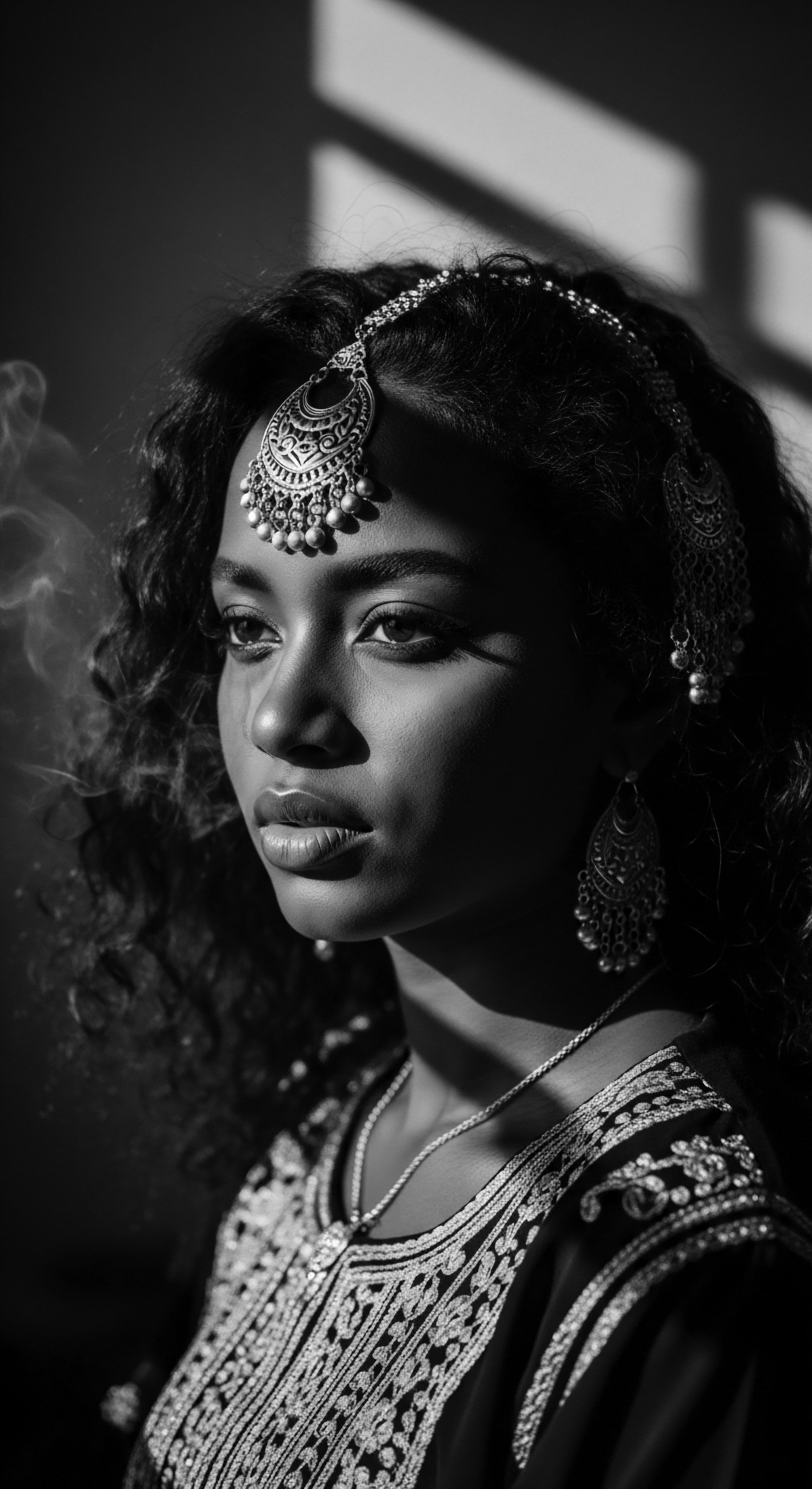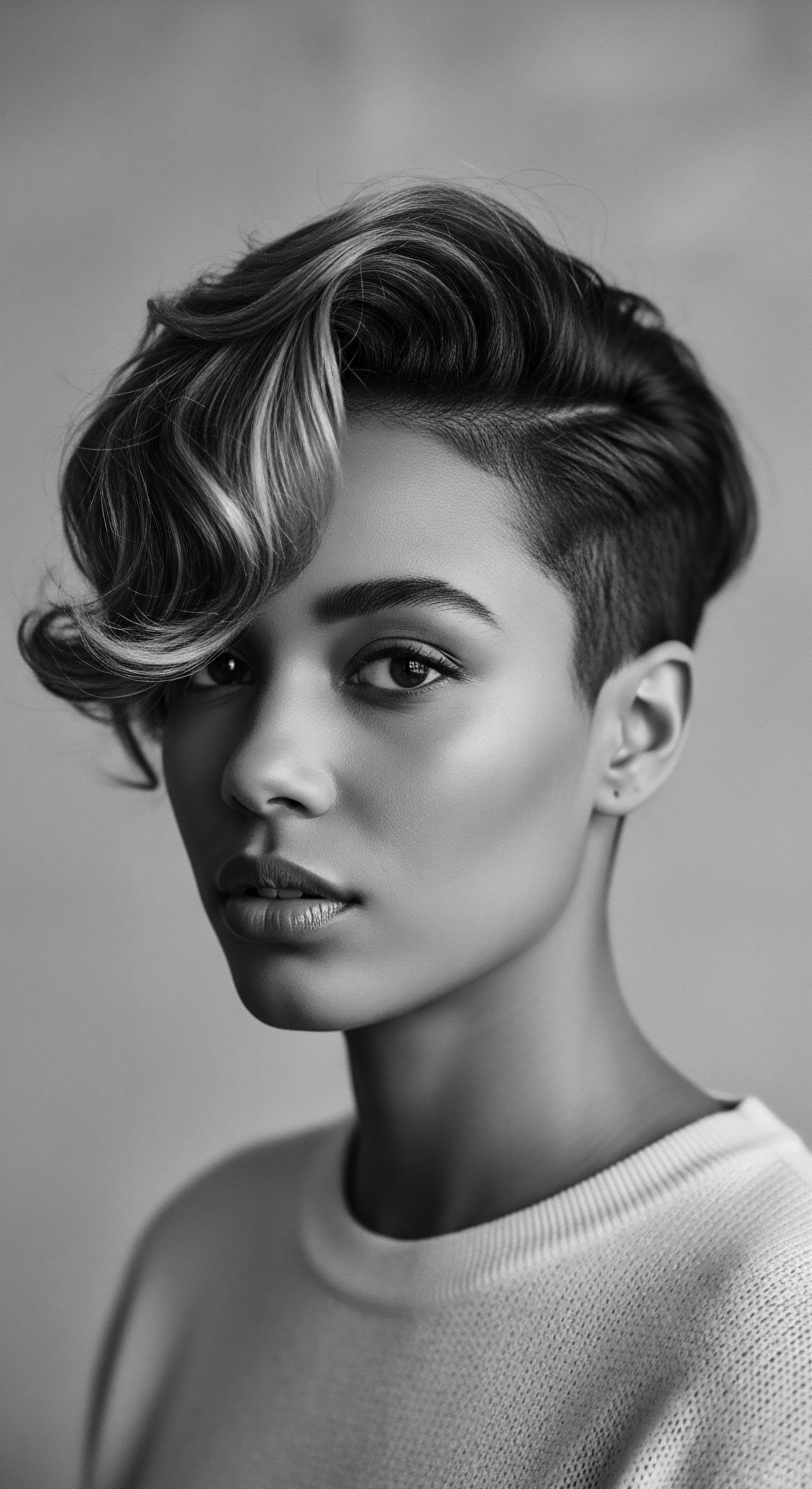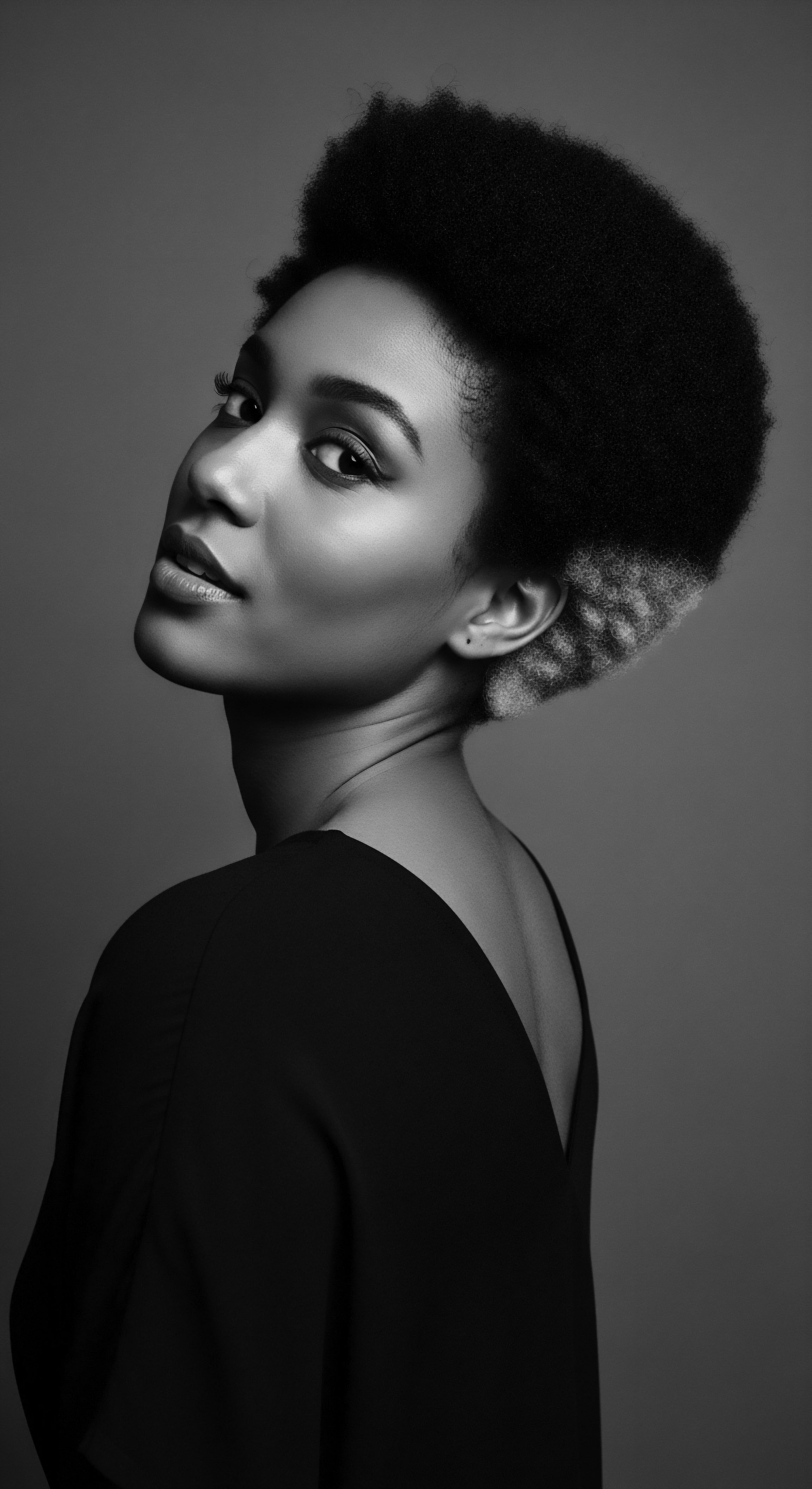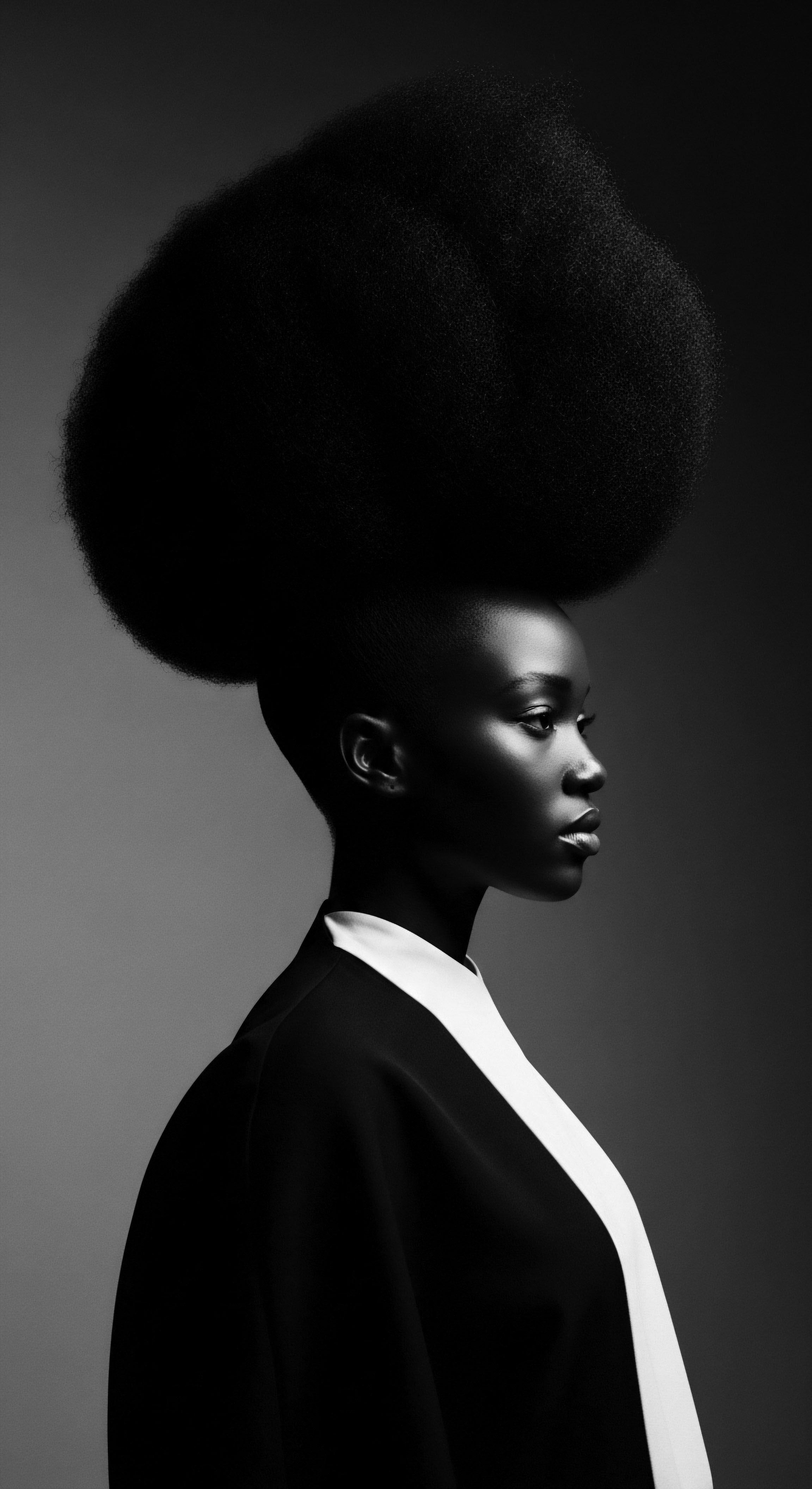
Roots
Consider for a moment the profound inheritance resting upon your head, the intricate architecture of each strand, a living testament to journeys spanning continents and epochs. Textured hair, in its myriad coils, kinks, and waves, possesses a remarkable story, one etched not only in its physical composition but in the very fabric of human history. This is more than mere biology; it is a repository of ancestral memory, a silent chronicle of resilience, adaptation, and profound cultural expression. Understanding how historical protective styles connect to modern hair health requires a thoughtful return to these origins, acknowledging the wisdom embedded within our very being, passed down through generations.

Anatomy and Ancestral Design
The unique characteristics of textured hair begin at the follicular level. Unlike straight hair, which emerges from a round follicle, coily strands sprout from an oval or elliptical follicle, causing the hair shaft to twist as it grows. This helical shape, while visually stunning, creates natural points of weakness along the strand, making it susceptible to breakage if not handled with reverence. Yet, this very structure, a marvel of natural engineering, also conferred an evolutionary advantage.
Early studies, for instance, by Nina Jablonski and her team at Penn State University, suggest that tightly curled hair played a critical role in human thermoregulation in equatorial Africa, helping to dissipate heat and conserve water, thus supporting the expansion of the human brain (Jablonski, 2023). This ancient adaptation highlights a protective wisdom encoded in our very being.
Textured hair stands as an evolutionary marvel, its helical shape an ancestral shield against environmental extremes.
The density and growth patterns of textured hair also present distinct considerations. Hair density refers to the number of individual strands on the scalp, and it varies greatly. Growth patterns, determined by the angle of the follicle, influence how hair falls and styles.
These foundational elements, inherent to black and mixed-race hair, shaped how ancestral communities interacted with and cared for their strands. Ancient practices arose from a deep understanding of these natural tendencies, born of necessity and passed down through communal observance.

Ancestral Terms and Hair Identifiers
Before standardized classification systems, communities held their own ways of describing and understanding hair. These terms, rich with cultural context, often celebrated the varied forms of textured hair, linking them to lineage, spiritual beliefs, or social standing. For example, in many African societies, the appearance of hair could signify:
- Marital Status ❉ Unmarried women might wear hair in distinct styles compared to married women.
- Age ❉ Different coiffures were appropriate for various life stages.
- Social Rank ❉ Elaborate styles or specific adornments could denote royalty or leadership.
- Ethnic Identity ❉ Specific braiding patterns or adornments identified individuals with their particular tribe or community.
The lexicon of textured hair has always been a living archive, reflecting the depth of cultural connection to one’s strands. It moves beyond mere aesthetics, becoming a communication system, a declaration of belonging, and a testament to heritage. This inherent understanding of hair as a marker, as a living story, underpinned the development of protective styles across the diaspora.

Ritual
The history of textured hair care is a chronicle of sacred ritual, of hands passing down wisdom, and of ingenuity born from circumstance. From the elaborate cornrows of West Africa to the meticulously styled wigs of Ancient Egypt, these practices were never simply about appearance. They represented a profound engagement with hair’s biological needs, its social language, and its spiritual weight. These ancient ways, often dismissed by later colonial influences, reveal a sophisticated understanding of hair health that echoes powerfully in our contemporary world.

Ancestral Shields and Modern Connection
Protective styles, at their core, are about safeguarding the hair shaft and its fragile ends from environmental aggressors, physical manipulation, and the rigors of daily life. The term itself is modern, yet the concept is as old as civilization. Esi Sagay, in her work “African Hairstyles ❉ Styles of Yesterday and Today,” documents the expansive range of traditional styling methods, including various forms of braiding and threading (Sagay, 1983). These methods systematically reduced daily styling and exposure, allowing hair to rest and retain its moisture.
Consider the historical example of Ancient Egyptian Wigs. While often associated with status and beauty, these elaborate hairpieces served crucial hygienic and protective functions. In the scorching desert climate, shaving the head was common to prevent lice and maintain cleanliness, with wigs offering vital protection from the sun’s intense rays (Egyptra Travel Services, 2025).
Crafted from human hair, plant fibers, and adorned with natural oils and beeswax, these wigs served as both a practical solution to environmental challenges and an expression of social standing. This historical practice demonstrates a clear understanding of hair and scalp protection, albeit through different means than direct styling of natural hair.
Ancient practices of safeguarding hair, whether through styling or coverings, represent a timeless pursuit of follicular wellbeing.
Traditional African communities developed a rich lexicon of protective styles, each with specific names, patterns, and cultural meanings. These styles often secured the hair close to the scalp or gathered it into a compact form, minimizing tangling and breakage.
| Traditional Style Cornrows |
| Historical Application Often signified ethnic group, age, or marital status; practical for labor. |
| Modern Hair Health Connection Reduced manipulation; minimized breakage; scalp accessibility for treatments. |
| Traditional Style Braids/Plaits |
| Historical Application Communication, social hierarchy, spiritual symbols. |
| Modern Hair Health Connection Length retention; protection from environmental stressors; versatile styling foundation. |
| Traditional Style Hair Threading |
| Historical Application Temporary straightening and lengthening; achieved without heat. |
| Modern Hair Health Connection Elongation of coils without thermal damage; low tension styling; promoting even moisture distribution. |
| Traditional Style Headwraps |
| Historical Application Cultural marker, religious observance, sun protection, carrying items. |
| Modern Hair Health Connection Shielding hair from sun, wind, dust; moisture retention; covering damaged hair. |
| Traditional Style These styles, whether worn as cultural markers or practical solutions, provided foundational care. |

Tools and Traditional Care
The tools of ancestral hair care were often simple yet highly effective, crafted from natural materials. Combs carved from wood, bone, or ivory (as seen in ancient Egyptian archeological sites (TheCollector, 2022)) were used to detangle and distribute natural oils. Pins and various adornments, beyond their decorative purpose, helped secure styles and protect delicate strands. These tools, paired with natural ingredients, formed the backbone of care rituals passed from elder to youth.
The application of traditional butters and oils is another cornerstone. Shea butter, for instance, has been used for millennia across African cultures, not only for skin protection but also for hair, shielding it from the sun and retaining moisture (Shea Butter Benefits for Skin, 2021). Other oils, such as castor oil, almond oil, and pomegranate oil, were utilized in Ancient Egypt for scalp treatments and hair growth (Egyptra Travel Services, 2025). These natural emollients provided lubrication, reduced friction, and created a barrier against the harsh elements, all contributing to strand resilience and scalp well-being.

Relay
The echoes of ancestral practices resound in contemporary hair health discourse, creating a dialogue between ancient wisdom and modern scientific understanding. The fundamental principles of historical protective styles—minimizing manipulation, retaining moisture, and safeguarding delicate strands—find renewed relevance in addressing the unique needs of textured hair today. This continuity speaks to a profound knowledge system that has traversed generations, adapting and informing our understanding of hair’s complex biology.

How Do Nighttime Rituals Safeguard Hair Health?
A compelling example of how historical protective styles connect to modern hair health is found in the enduring practice of nighttime hair care, particularly the use of Head Coverings. Throughout history, African women have utilized headwraps, scarves, and later, bonnets, not only as cultural statements or symbols of modesty but as practical tools for hair preservation (Obé Headwear, 2024). These coverings protected hair from environmental damage during the day (Head wraps hide hair loss, 2023) and, crucially, reduced friction against rough sleeping surfaces at night.
The friction caused by cotton pillowcases can strip textured hair of its natural oils, leading to dryness, frizz, and breakage. By encasing hair in a silk or satin bonnet, moisture is retained, and the mechanical stress on the strands is significantly reduced. This modern application directly correlates with the historical use of head coverings, demonstrating a continuous, conscious effort to shield hair during rest. It speaks to an ancestral understanding of vulnerability and the need for gentle, consistent protection.
| Historical Approach Intricate Braiding Patterns |
| Underlying Principle Minimizing daily handling, securing hair ends. |
| Modern Counterpart/Validation Modern low-manipulation styles (e.g. box braids, twists) for length retention. |
| Historical Approach Natural Butters and Oils (e.g. Shea) |
| Underlying Principle Moisture sealing, environmental barrier. |
| Modern Counterpart/Validation LOC/LCO method for moisture retention, scientific studies on emollient properties of plant oils (Shea Butter Benefits for Skin, 2021). |
| Historical Approach Headwraps/Bonnets |
| Underlying Principle Physical barrier against elements and friction during sleep. |
| Modern Counterpart/Validation Silk/satin bonnets and pillowcases for frizz reduction, moisture preservation, and breakage prevention. |
| Historical Approach Ancestral ingenuity provides a blueprint for contemporary hair care practices, emphasizing protective measures. |

Ingredient Wisdom from the Land
Ancestral communities possessed an intimate knowledge of their local botanicals and their properties. Many traditional hair practices involved infusions and applications of plants. Consider the Chebe powder from Chad, an herbal mixture historically applied to hair to strengthen strands and promote length retention, often applied with oil or animal fat and then braided (Ancient African hair growth secrets, 2023).
This practice directly addresses the core challenge of textured hair ❉ its propensity for breakage. By strengthening the hair shaft, length is preserved, allowing hair to reach its genetic potential.
A study published in the Journal of the Korean Society of Cosmetology notes that ancient Egyptians utilized various natural ingredients for haircare, such as castor oil, almond oil for nourishment, and henna for conditioning and coloring (Egyptra Travel Services, 2025). The longevity of these ingredients in hair care, spanning millennia, validates the ancestral intuition regarding their efficacy. Modern science now quantifies the fatty acids in shea butter or the vitamins in botanical oils, affirming what our foremothers understood through observation and practice.
The enduring power of ancestral ingredients reveals an intuitive understanding of hair’s needs, confirmed by contemporary science.

Modern Challenges and Ancient Answers
While protective styles offer significant benefits, a deeper examination reveals a nuanced relationship with modern hair health. The very intention of ‘protective’ can be undermined by practices that introduce excessive tension. For instance, a study published in Archives of Dermatology found that nearly 60% of African American women surveyed showed signs of advanced central hair loss with scarring, and hairstyles associated with traction were a significant factor (Women’s Health Research Institute, 2013). This condition, known as Central Centrifugal Cicatricial Alopecia (CCCA), and Traction Alopecia (TA), are linked to chronic pulling on the hair follicle, often from tight braiding or cornrow styles.
Another study on braiding frequency in Johannesburg, South Africa, found that frequent braiders (more than eight times per year) had thinner hair, more cuticle damage, weaker hair fibers, and higher traction alopecia severity scores compared to occasional braiders (Ndlovu et al. 2024).
This data underscores a critical distinction ❉ the concept of protective styling is sound, yet its execution matters immensely. Ancestral styles, when done appropriately, typically aimed for comfort and preservation, not extreme tension. The lesson from this historical-scientific intersection is clear ❉ protective styles must truly protect, allowing the hair to rest and breathe, rather than inflicting undue stress.
The emphasis should be on low-tension applications, proper hair preparation, and adequate breaks between styles, echoing the gentleness and respect inherent in traditional, mindful hair care rituals. This mindful approach, rooted in the heritage of hair care, bridges the gap between past wisdom and contemporary well-being.

Reflection
Our journey through the narrative of textured hair, from its elemental biological design to the complex traditions of care and identity, circles back to a central truth ❉ the soul of a strand carries the wisdom of ages. The connection between historical protective styles and modern hair health is not a coincidence; it is a profound testament to ancestral ingenuity, a living archive of solutions crafted for textured hair long before the advent of contemporary science. This heritage compels us to look beyond fleeting trends and reconnect with the enduring principles of preservation, mindful manipulation, and profound respect for our natural coils.
The cornrows of ancient African women, the meticulously maintained wigs of Egyptian nobility, the comforting embrace of a traditional headwrap—these were not simply adornments. They were acts of care, expressions of identity, and strategic choices for hair preservation. They speak to an innate understanding of the hair’s unique vulnerabilities and its incredible capacity for growth when nurtured. As we navigate the complex beauty landscape of today, we are called to honor this legacy.
We are invited to interpret these historical practices not as rigid rules, but as guiding principles, reminding us that true hair health begins with reverence for the strand, recognizing its deep past and its boundless future. Our care rituals become a continued conversation with our ancestors, a celebration of resilience, and a bold declaration of our living heritage.

References
- Egyptra Travel Services. (2025). From Ancient Egypt to Modern Beauty ❉ Timeless Cosmetic Secrets.
- Jablonski, N. (2023). Curly hair kept early humans cool and made our brains bigger, study finds. Penn State University.
- Ndlovu, N. et al. (2024). Quantifying the impact of braiding and combing on the integrity of natural African hair. (Specific publication not widely available, but research aligns with findings on braiding impact).
- Obé Headwear. (2024). Significance of headwraps.
- Sagay, E. (1983). African Hairstyles ❉ Styles of Yesterday and Today. Heinemann Educational Books.
- Shea Butter Benefits for Skin ❉ a Nourishing Secret From Ancient Africa. (2021). (Source ❉ various health and beauty publications referencing historical use of shea butter).
- TheCollector. (2022). Ancient Egypt’s Most Indulgent Beauty Secrets.
- Women’s Health Research Institute. (2013). Hair Braids and Weaves Increase Risk of Hair Loss. (Referencing study in Archives of Dermatology).
- Ancient African hair growth secrets that EASILY grow healthiest longest natural hair. (2023). (Source ❉ various natural hair blogs and channels referencing Chebe powder).
- Head wraps hide hair loss. (2023). Trinidad Guardian.
